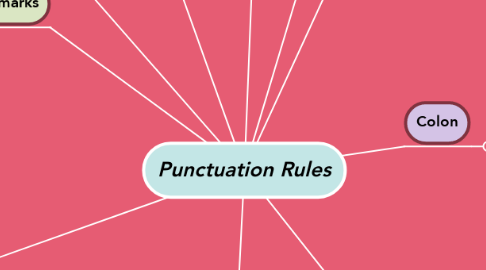
1. Hyphen
1.1. Uses
1.1.1. In compound words
1.1.2. With prefixes and suffixes
1.1.3. To link names
1.1.4. In compound numbers
1.1.5. Nouns that follow a single letter
1.1.6. To create special effects
2. Parentheses, Dash, and Ellipsis
2.1. Parentheses uses
2.1.1. To enclose an interrupting word
2.1.2. To clarify an idea
2.1.3. To show equivalent measures
2.1.4. To enclose directions
2.2. Dash
2.2.1. More commonly used in informal writing.
2.3. Ellipsis
2.3.1. Three dots that indicate the omission of words.
3. Quotation marks
3.1. Indicate direct quotations and enclose the exact words of a speaker and are used in a few other special situations
3.2. Quotation within quotation
3.3. Rules
3.3.1. Comma between the quotation speaker
3.3.2. Periods always inside the quotation
4. Semicolon
4.1. Uses
4.1.1. In a place of a coordinate conjunction to show cause and effect
4.1.2. To connect sentences that are closely related
4.1.3. To separate a statement from its explanation
4.1.4. To separate items in a series
5. Malexy Ruiz Robles 😊
6. Do not use them to form plurals
7. Comma
7.1. Uses
7.1.1. Separate items in dates and places
7.1.2. Openings of friendly letters
7.1.3. To separate initials and titles from surnames
7.1.4. Between words
7.1.5. Separate adjectives before a noun
7.1.6. Before a coordinate conjunction in a compound sentence
7.1.7. To set off appositives
7.1.8. In quotations
7.1.8.1. To set off non-essential words
8. Apostrophe
8.1. Uses
8.1.1. Replace missing letters
8.1.2. Form contractions
8.1.3. Show possession
8.2. Misuses
8.2.1. Match the apostrophes with acronyms
9. Colon
9.1. A piece of punctuation that has a number of functions.
9.1.1. Uses
9.1.1.1. After a greeting
9.1.1.2. To separate hours and minutes
9.1.1.3. To Express a ratio
9.1.1.4. To separate a title from a subtitle
9.1.1.5. To separate acts from scenes in a play
9.1.2. More complex uses
9.1.2.1. To introduce items in a long list
9.1.2.2. Introduce a quotation
9.1.2.3. Introduce an explanation or definition
9.1.2.4. To highlight a situation
10. Capitalization
10.1. Capitalize the first word of a sentence and the names of people, places or things.
10.2. Personal pronoun "I"
10.3. Capitalize the first word in a direct quotation
10.4. Don't capitalize
10.4.1. ° Compass directions
10.4.2. Words in titles
10.4.2.1. Coordinate conjunctions
10.4.2.2. Articles
10.4.2.3. Short prepositions
